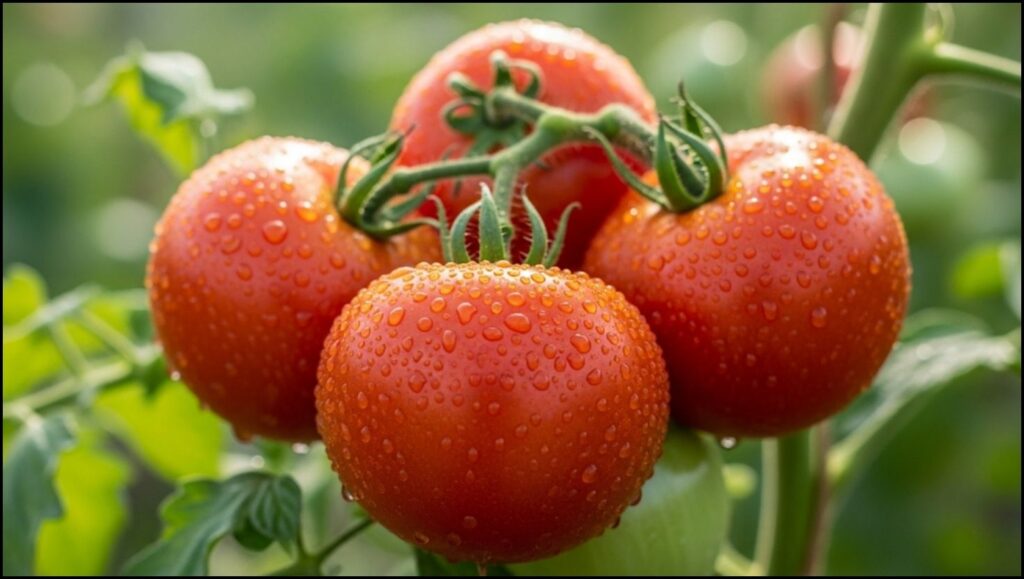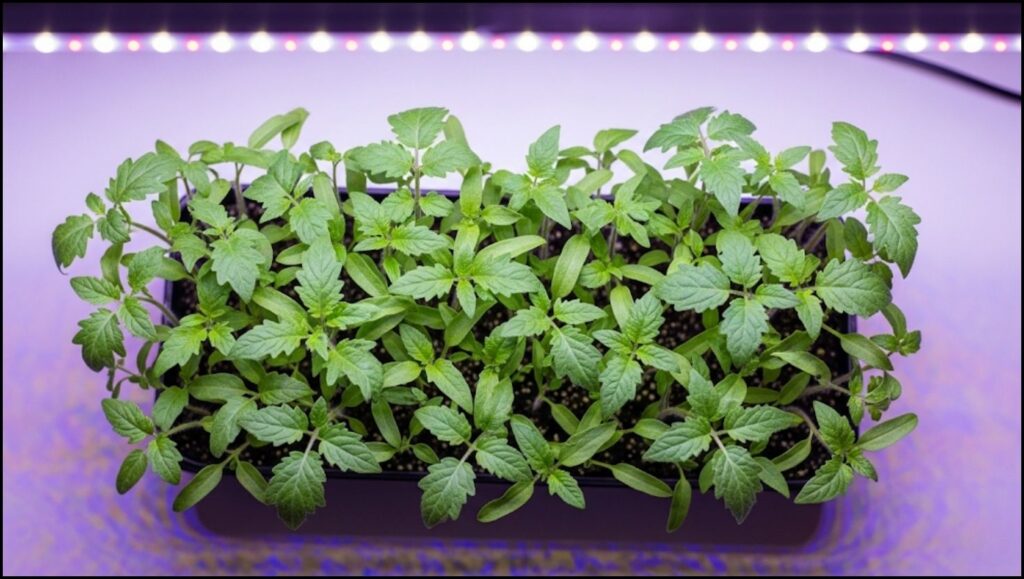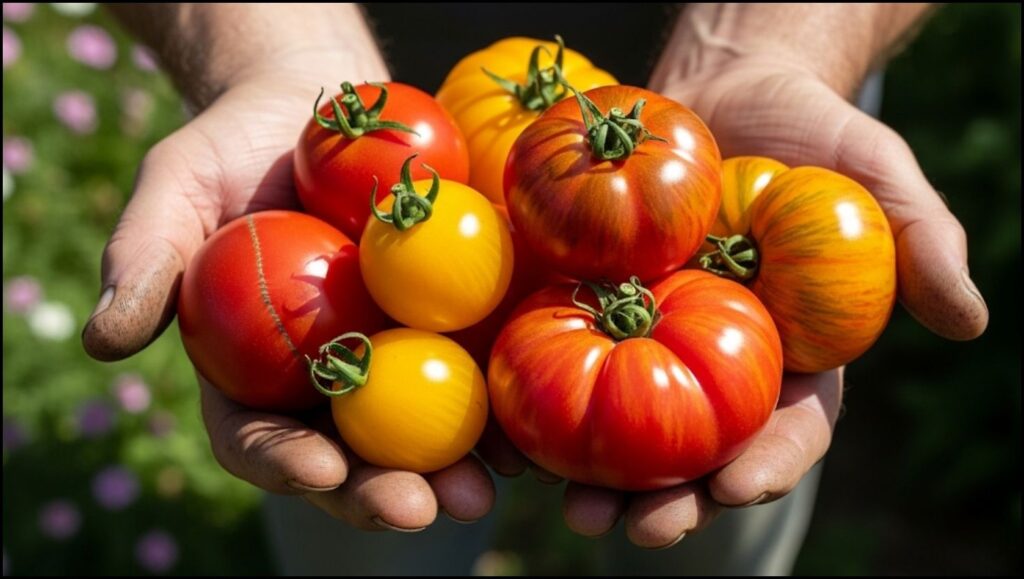
There is perhaps no greater reward in the garden than the taste of a truly sun-warmed tomato, picked at its peak of perfection. It’s a quintessential summer experience. But for many gardeners, the journey to that first bite is clouded by one simple question: How long does it really take? The number printed on a seed packet “days to maturity” can feel like a cryptic clue rather than a straightforward answer.
This guide will demystify the entire process for you. We’ll walk through each stage of the plant’s life, from a tiny seed to a heavy, fruit-laden vine, so you can plan your season with confidence and know exactly what to expect. Let’s cultivate some clarity and get you on the path to the most delicious harvest yet.
Key Timelines at a Glance
Here is the essential tomato growing timeline you need to know. Remember that these are averages, and your unique garden conditions will play a role.
- Seed Germination: 5 to 10 days
- Seedling Growth (Indoors): 4 to 6 weeks
- From Transplant to First Flowers: 20 to 30 days
- From Flowers to Ripe Fruit: 30 to 60 days
- Total Time From Seed to First Harvest: Approximately 100 to 120+ days (about 3-4 months)
Decoding “Days to Maturity for Tomatoes”
Before we dive into the week-by-week journey, it’s crucial to understand what that number on your seed packet or plant tag actually means. “Days to maturity” is the estimated time from the moment you transplant a healthy seedling into the garden until you can expect your first ripe fruit. It does not include the 4 to 6 weeks it takes to grow that seedling from seed.
In my own garden, I treat this number as a helpful guide for comparison—an ‘early’ variety might be 55 days, while a main-season beefsteak could be 85 days—but never as a rigid deadline. Nature, after all, has its own beautiful rhythm. Factors like sunlight, soil temperature, and proper nutrition will always influence the final schedule, a principle well-documented by horticultural experts at institutions like the University of Minnesota Extension.
The Complete Tomato Growing Timeline: From Seed to Harvest
Growing a tomato is a story told in four parts. Understanding each chapter helps you provide the right care at the right time, ensuring a happy ending.

Stage 1: Germination & Early Seedling Life (1-2 Weeks)
This is where it all begins. When planted in moist, warm soil, tomato seeds will typically sprout in 5 to 10 days. Once they emerge, these tiny seedlings, called cotyledons, will unfurl their first set of “seed leaves.” Within another week, their first true leaves will appear, and their journey truly begins. During this time, they require at least 14-16 hours of bright light from a grow light to prevent them from becoming weak and leggy.
Stage 2: Seedling Development & Hardening Off (4-6 Weeks)
For the next month or so, your primary job is to nurture your seedlings into robust young plants. They will develop several sets of true leaves and a strong root system. A common mistake I see new gardeners make is transplanting them outside too soon. They need to be gradually acclimated to outdoor conditions—a process called hardening off. Over a week or two, you’ll slowly increase their exposure to sunlight and outdoor temperatures before they are finally planted in the garden. This crucial step prevents shock and ensures they don’t miss a beat.
Stage 3: Vegetative Growth & Flowering (3-5 Weeks After Transplant)
- Once in the garden, your tomato plant will spend the next few weeks focusing on “settling in” and putting on significant vegetative growth—that is, growing bigger, stronger stems and more leaves. This phase is all about building the factory that will produce your fruit.
- Roughly 20 to 30 days after transplanting, you’ll see the magical appearance of the first yellow flower trusses. Each of these flowers holds the potential for a tomato. Proper pollination, aided by wind and buzzing bees, is essential here.
Stage 4: Fruit Set & Ripening (5-8 Weeks)
After a flower is successfully pollinated, its petals will fall away, and you’ll see a tiny, green orb begin to swell at its base. This is it a baby tomato!
The time from this moment of fruit set to a fully ripe tomato can vary dramatically, typically taking anywhere from 30 to 60 days. Smaller varieties like cherry tomatoes will ripen much faster than large beefsteaks. The fruit will first grow to its mature size and then begin the ripening process, changing from green to its final, glorious color. This final stage is powered by warmth and sun, with a substance called ethylene gas acting as the primary ripening hormone within the fruit.
Choosing Your Speed: Factors That Influence How Long to Grow Tomatoes
Not all tomatoes are on the same schedule. You can strategically influence your harvest date by making smart choices from the very beginning.
The Critical Role of Tomato Variety
Your choice of tomato variety is the single biggest factor in determining your harvest timeline. Tomatoes are generally grouped into two growth habits:
- Determinate (Bush) Tomatoes: These plants grow to a predetermined, compact size, set all their fruit in a concentrated period of a few weeks, and then are largely finished. They are excellent for container gardening and for those who want a large harvest at once for canning or making sauce. Many of the fastest growing tomatoes fall into this category, with some varieties ripening in just 50-60 days from transplant.
- Indeterminate (Vining) Tomatoes: These plants grow and produce fruit continuously throughout the season until the first frost. They require tall, sturdy staking or caging. While they may take longer to produce their first ripe fruit (often 70-90 days), they provide a steady supply all summer long. Most heirloom and cherry tomato varieties are indeterminate.
Seeds vs. Starts: Getting a Head Start
Starting with established seedlings, or “starts,” from a reputable nursery is a wonderful shortcut. This effectively lets you skip the first 4-6 weeks of the tomato growing timeline, placing you directly at the transplanting stage. It’s a fantastic option for gardeners with a short growing season or for anyone who simply wants to get a jump on things.
The Unsung Heroes: Sun, Soil, and Temperature
Even the perfect variety will lag behind if its basic needs aren’t met.
- Sunlight: Tomatoes are sun-worshippers. They need a minimum of 6-8 hours of direct sunlight per day to photosynthesize effectively and produce the sugars that make them sweet.
- Soil: The best soil for tomatoes is well-draining, rich in organic matter, and has a slightly acidic pH (6.2-6.8). Good soil structure allows roots to breathe and access nutrients efficiently. Before planting, I always amend my beds with a generous amount of aged compost.
- Temperature: Tomatoes thrive in warmth. According to a report from PennState Extension, fruit set can be negatively impacted when nighttime temperatures drop below $55^\\circ F$ ($13^\\circ C$).

A Harvest Worth the Wait
From the moment you press a seed into the soil to the day you taste that first juicy slice, the tomato growing timeline is a journey of about four months. While it requires a measure of patience, the process is one of the most rewarding endeavors in gardening. By understanding each stage, selecting the right varieties for your goals, and providing thoughtful care, you are not just growing food; you are cultivating an experience.
Now that you know how long to grow tomatoes, you can map out your season, choose your plants with purpose, and anticipate a summer filled with the unparalleled flavor of home.
More Than a Hobby: How Self-Watering Container Gardens Ideas Address Urban Food and Water Challenges
